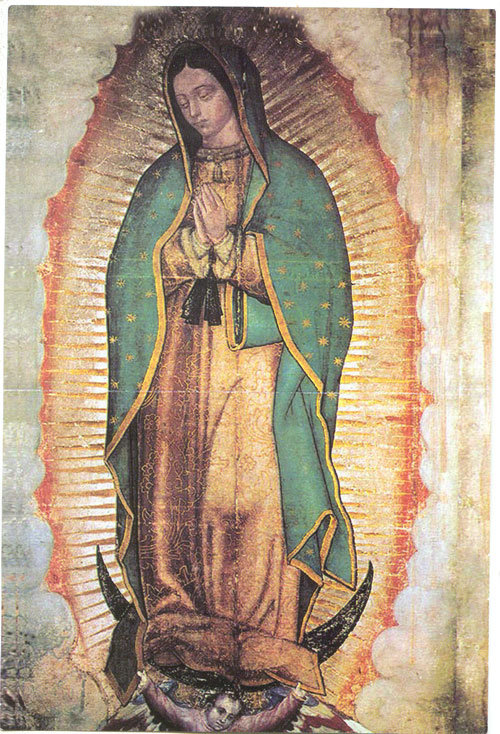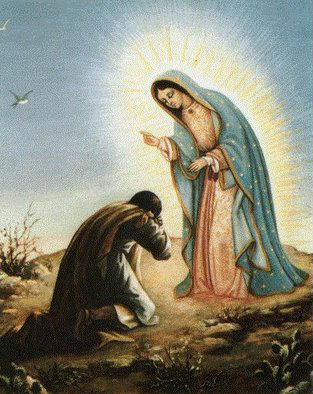|
The first miracle of the mantle of the Virgin Mary was created by the Mother of God December 12, 1531. Mary had asked Saint Juan Diego to go to the summit of Mount Tepeyac to pluck the flowers that were there to take them to the bishop of Mexico, which had requested the Heaven a sign to ensure the truth of Mary's request through his humble messenger. The Blessed Virgin asked indeed we build a chapel in her honor at the summit of Mount.
Depositing his poncho before the bishop, they saw drawn image of the Most Holy and Ever-Virgin Mother of the true God , an image that still persists today. December 26, 1531, there was a procession to Mount Tepeyac where met many Indian Chichimecs, they played with their bows and arrows and danced according to their customs. Unfortunately an arrow shot at random pierced the throat of an Indian who accompanied the " Coat " . He died at the moment . In front of the image arrow and immediately withdrew it was seen to form a scar and the Indian resurrected . From this point, the Indians converted to Catholicism in number 9,000,000. In 1751, Michel Joseph Cabrera Ibarra analyzed with the poncho and they found that the image had no brush marks . In 1791, muriatic acid fell on the upper right side with a proportion of 50% nitric acid and 50 % hydrochloric acid, making a hole 10 cm in diameter. Thirty days after the tissue was reformed and no one intervened to repair the accident. Today , there is a brand of stain and only by means of a precision instrument can be observed burn marks . In the eighteenth century, there was a very similar copy of the original with the same fabric maguey (cactus plant fibers): Anyway, the copy was reduced to dust some fifteen years later, while the original already has nearly 500 years, which is an inexplicable phenomenon. Coat measuring 1.71 high and 1.05 wide. On 14 November 1921, the stonemason Lucien Perez , an anarchist, lays a bouquet of flowers at the foot of the mantle of Juan Diego, in which he had put a load of dynamite that destroyed all around, but left intact the poncho and the glass that protected it. In 1929, photographer Alfonso Gonzalez Marcue discovered a human figure in the right eye of the Virgin. In 1936, the Bishop of Mexico was analyzed three fibers mantle (which later gave the Nobel Prize in Chemistry for 1938 and 1949). Dr. Richard Khun Jewish discovered that the paint of the picture had no origin plant, mineral or even animal, or any of 111 pigments known in the world. Khun concludes that the paint is not of human origin.
In 1956, the ophthalmologist
Torruela Bueno discovers that approaching the eye to make a fundus, the
pupil closes and removing the light, the pupil dilates again as if it were
a human eye . In July 1956, Dr. Lavoignet after eight months of intense
work discovers the optical phenomenon of the triple image of
Purkinje-Samson is what the human eye perceives, that is to say, the three
refractions of object seen. In February 1979, Dr. Jose Aste Tonsmann , head of IBM Scientific Center in Mexico City, discovered in turn, with powerful computers inexplicable phenomena in the pupils of the eyes of the Virgin Mary, which have a diameter of 8 mm., in digital form, you can see twelve characters who look at the picture of the Virgin of Guadalupe. But that does not stop the wonderful coast of surprise. Indeed, expanding the pupil of one of the characters in the scene, that is to say, Bishop Juan de Zumárraga, so an expansion of a few thousand times those of the Virgin, is 2,500 times more then we see the Indian Saint Juan Diego showing the poncho with the image of the Virgin of Guadalupe. Thus, a quarter of a micron, which is part of the π-millionth of a millimeter , Professor Aste Tonsmann could see an extraordinary scene, a discovery that deprived him sleep for several nights . On 7 May 1979, scientists Brand Jody Smith, professor of aesthetics and philosophy Philipp Serna Callahan, biophysicist at the University of Florida and a specialist in painting and both members of NASA, have not met painting in the original poncho. They prove that this is not a photograph that would have printed the fabric . They also discovered that the poncho maintains without explanation the human body temperature hovering around 36.6 ° - 37 °. And December 22, 1981 , Father Mario Rojas, in turn discovers the Observatory " Laplace " Mexico that stars mantle correspond to the winter solstice of December 12, 1531 to 10: 26 on the territory of Mexico, that is to say at the time when St. Juan Diego unfolded his poncho before the bishop. Astronomers certified this fact. Two angels were painted later side of the Virgin outside rays but thirty days after they disappeared and today, thanks to highly specialized and sophisticated tools, we can find the trace. You can also see traces of a painted on the head of the Virgin crown. These paintings date from the eighteenth century. Paint was applied to the angel of the lower part of the gold and silver rays of the cord and the serpent under the feet of the Virgin. This painting is disappearing to restore the original colors engraved December 12, 1531 . If the approach is less than 10 cm canvas we see that the fibers of the coat without any color. The NASA scientists also discovered that laser passing on canvas but laterally within the ray passes without touching the paint or canvas so that the image is suspended in the air three tenths of a millimeter above the fabric . Finally, the gynecologist, placing his stethoscope on the belt of the Virgin Mary, who is pregnant, heard the sound of the heart beat and found they amounted to 115-120 beats per minute, which corresponds to the heartbeat the heart of the Child Jesus , like those of a fetus in the womb of his mother. On 24 April 2007, at the end of the Mass offered for the aborted unborn children, the assistance of the Basilica wondered what expect the Blessed Virgin of Guadalupe. Mexico City Council had legalize abortion on demand hitherto prohibited. While many of the faithful took photographs of the ayate Tepeyac, exposed and venerated in the Basilica and at whose feet the crowd of pilgrims scrolls on a treadmill, the image of the Virgin began to fade, to give Place a bright light emanating from her belly, forming a bright halo in the form of an embryo. With framing and high magnification it is possible to appreciate the position of the light actually comes from the belly of the image of the Virgin Mary and is neither a reflection nor an artifact. The engineer Luis Girault who studied the picture thus obtained confirmed the authenticity of the negative and has been clear that it was neither amended nor altered by superimposing another example image. He discovered that the image not from any reflection, but literally out of the interior of the image of the Virgin. The light produced is very white, pure and intense, different from the usual photographic lights produced by flashes. This light is surrounded by a halo and appears to float inside the abdomen of the Virgin. This halo has the shape and measurements of an embryo. Indeed, if we examine more precisely the image by turning in a sagittal plane, there are inside the halo some gray areas which have the characteristics of a human embryo in the womb.
Source: |

